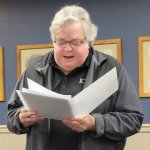WOODBINE — The roof of Woodbine Elementary School leaks in many places, its boiler (vintage 1964) chugs along at an estimated 74 percent efficiency, some classrooms have just two electric outlets, and exterior doors need replacing.
There are a host of other upgrades, including solar panels on the roof, that the pre-K to grade 8 district officials would like to make to improve the facility 224 pupils attend, including 3-year-olds in full-day pre-kindergartens.
To make the repairs happen would cost about $6 million.
School officials say a straw poll of borough residents and taxpayers showed support for the special project, if it would not hike taxes.
To get that zero tax increase for borough residents, the state Department of Education would “guarantee” $3.5 million, of the $6 million, (58 percent) but the remainder is about $2.5 million (with debt service payments of $551,655 per year for 15 years.)
The latter is more than the school district’s roughly $4.9 million bonding capacity, thus the need for borough-assisted bonding power.
The school tax is presently 70.67 cents per $100 of assessed value.
Annual district savings, resulting in the zero tax increase would mean $321,427 state aid, $156,800 in solar energy sales,
$50,333 in electrical savings, $15,000 in building energy savings in windows, doors and boiler), and $10,000 (county) library utility reimbursement.
The Board of Education notified county election officials of a Dec. 8 referendum. Some members attended an Oct. 1 Borough Council meeting to pitch the idea, and ask the borough to bond about $2 million of the project.
The proposal got less than a warm reception, in part, according to Mayor William Pikolycky, due to lack of communications on the district’s part. He believes school officials knew long before Oct. 1 of the plan, and should have shared it earlier.
District Superintendent Lynda Anderson-Towns and Business Administrator Alan Parmalee showed the Herald through the school Oct. 7, and cited items in need of repair.
Most recently, a $5 million grant funded construction of a gymnasium, school and county libraries, computer lab and some classrooms, all at no cost to the taxpayers, Anderson-Towns said.
If the district waited, said the mayor, he is certain all or most of the repairs could be similarly done and funded by various state grants.
“Other parts of the school are outdated. Classrooms, the kitchen, all purpose room,” she said.
The stove in the kitchen cannot be used because the hood over it, although stainless steel does not contain a required $17,000 fire suppression system, she continued.
District Architect of Record, Design Collaborative (Deco) of Court House was enlisted to assist securing grants, Anderson-Towns said.
A long-range facilities study was done to bring the building up to code, especially to ADA (handicap accessible) standards. Three phases of the project were decided.
First, the roof and boiler (oil-fired hot water) need replacing.
“We know we are losing energy,” said Anderson-Towns.
Of the small kitchen, Anderson-Towns said there have been “several crises” including flood caused by broken pipes “because it is so dated.”
Her main area of concern is, “This is an emergency site as well as for the safety of our children.”
Because of lack of electrical outlets, technology suffers, since computers and Smartboards require more energy that can be safely delivered.
“As a district, we have been aggressive in pursuing grants for equipment to be put in place,” she said. “But the lack of technology has impacted some educational programs.”
Parmalee said the mayor and school officials traveled to Trenton in search of grants in November 2007.
“After a talk with the mayor, it was decided that grants would not be there,” said Parmalee.
That’s when the architect began to “plug into” the concept of solar energy.
Today, Parmalee said, that project could be an income generator for the district, as well as supplying electrical needs and helping local utilities reach state-mandated “green” energy generation.
The present boiler, tested three years ago, found to work at 74 percent efficiency, could be replaced with modern ones that operate at 90-95 percent efficiency, Parmalee said.
He said natural gas seems favored as a fuel, and if one boiler was replaced with two or three, it’s possible in cool weather to use one, and in bitter cold, fire up all three.
Third phase would be for mechanical systems, ventilation, lighting and the kitchen.
An upgrade of the security system, with new entry doors and a camera system is also being eyed, to make the school safer from intruders, said Anderson-Towns.
The district received 58 percent funding from the state, $307,526 out of $527,813. A local matching portion is $220,227.
“We communicated with the mayor and he indicated he would pursue a Small Cities grant, so we took that out of the bond referendum,” said Anderson-Towns.
“About 50 percent of the borough council was for the referendum,” said Anderson-Towns.
County Executive Superintendent Terrence Crowley has assured her that the school, although small, will remain open, in part, because many of its students walk.
“Mr. Crowley said it would not be reasonable to close a walking-school district and bus students to another district,” Anderson-Towns said.
Towns said borough recreation programs use the school gym and some churches use the facility.
“It is the focal point of the community,” she continued.
“I was first, shocked as were some council members, that without consulting the borough in looking at how to continue to fund the community school we worked so hard to get,” said Pikolycky.
He cited the $5 million addition, done “at no cost to the local taxpayers,” that got them a library, driveway and parking facilities.
“I don’t think it’s a good idea being told ‘We don’t have the (bonding) capability to borrow, we’ll use somebody else’s,’” said the mayor.
“I have a major concern on that part,” he continued.
“They (school district) were told to do an energy audit by the BPU (Board of Public Utilities). They have not done that,” said Pikolycky. He added that a BPU speaker is expected to attend council’s Nov. 5 meeting. He hopes Board of Education members will attend, he said.
Money is available from the BPU, said Pikolycky, and the district ought to postpone its referendum, seek more grants, and possibly reschedule the special vote later in spring 2010.
“The problem is, they (district) went ahead without telling anyone months ago,” he continued.
“They’ve been hiding this for six months,” said Pikolycky.
The mayor is confident the required 42 percent local match could be secured by grants, removing any future debt burden from taxpayers.
If the district is eyeing solar panels, Pikolycky said they, too, could be largely funded through state energy grants.
He said an energy audit may reveal, “They might not need solar panels…The school should not be getting into the energy business,” the mayor continued.
“Six million would kill us,” said Pikolycky.
He believes the state Department of Education would not have allowed the recent $5 million project to be attached to the school had state officials believed the school had too many “deficiencies.”
Because of the borough’s most recent 8.3 unemployment rate, “the highest in the county,” said Pikolycky, “We can show we are really hamstrung at all angles.”
“Statistics put us in a strong position,” said the mayor. He cited numerous grants received, from $450,000 for streetscaping to the bike path, which was possible due to the municipality’s diverse demographics.
“I’m disappointed they didn’t solicit our input, and ask ‘How is the best way to do this?’” he added.
A $1.2 million grant application has been submitted, he said, to assist with the school’s heater woes.
“That would lower what needs to be bonded,” he added.
Pikolycky said board members “walked out when I asked them to table the referendum. I was saying ‘Let’s work together and come up with a plan,’” he said.
If the referendum passes, Pikolycky said it would mean a $400 tax increase to taxpayers.
“That would be a 34-cent increase in taxes, and I‘m concerned because of the bonding,” he said.
He also wonders why the district went ahead, secured the aid of its architect and secured a marketing firm (I-E Communications) to forge ahead with the plan to inform the public.
“They had to know months ago. Why didn’t they say anything then?” Pikolycky asked.
Contact Campbell at (609) 886-8600 Ext 28 or at: al.c@cmcherald.com
Cape May – Last week I witnessed a woman helping a man who seemed to be having difficulty getting up in the water. the next thing I saw was she also was injured. My Uber ride was there to take me to the…







